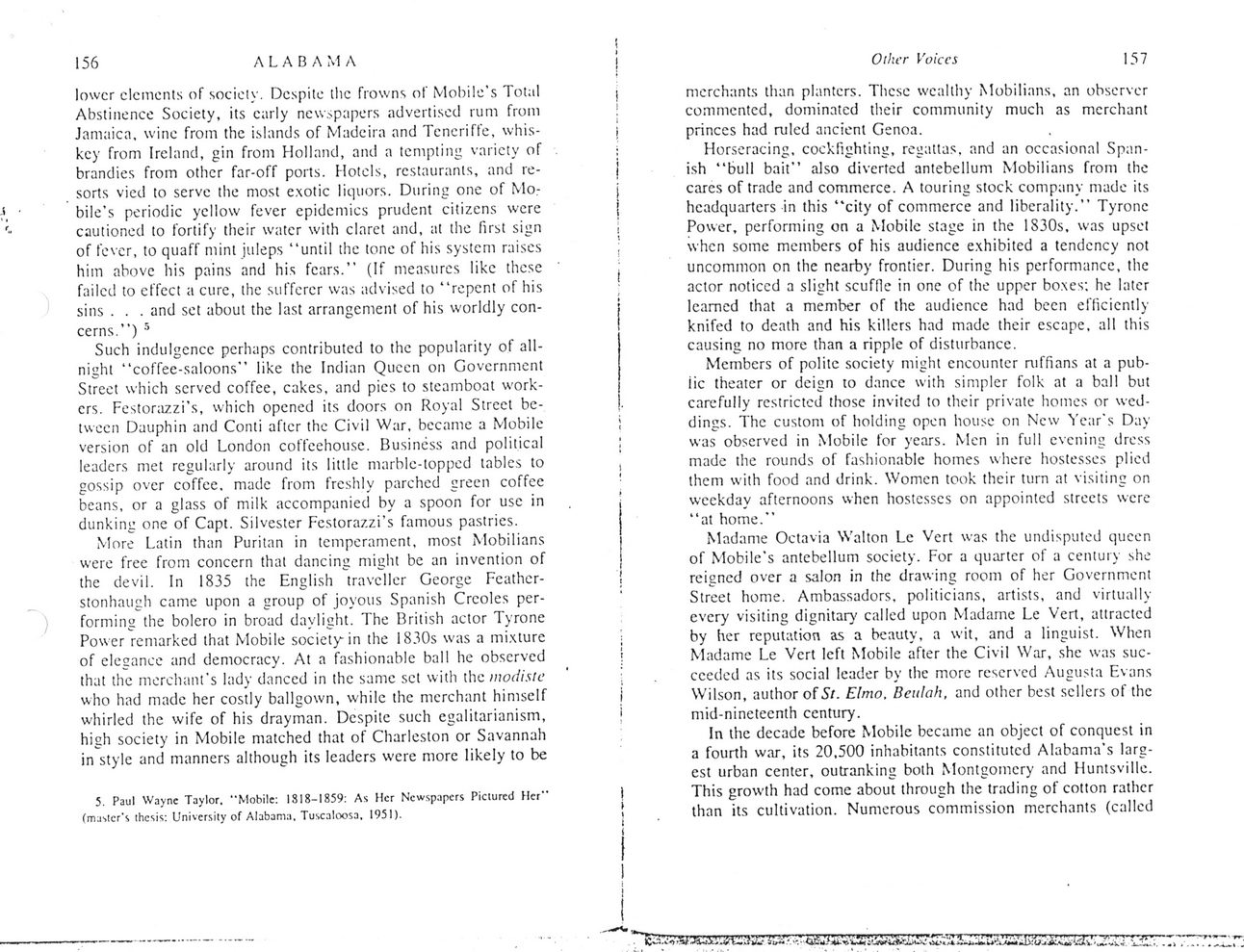This text was obtained via automated optical character recognition.
It has not been edited and may therefore contain several errors.
156 ALABAMA lower elements of society. Despite the frowns of Mobile?s Total Abstinence Society, its early newspapers advertised rum from Jamaica, wine from the islands of Madeira and Teneriffe, whiskey from Ireland, gin from Holland, and a tempting variety of brandies from other far-off ports. Motels, restaurants, and resorts vied to serve the most exotic liquors. During one of Mo: bile?s periodic yellow fever epidemics prudent citizens were cautioned to fortify their water with claret and, at the first sign of fever, to quaff mint juleps ?until the tone of his system raises him above his pains and his fears.?? (If measures like these failed to effect a cure, the sufferer was advised to ?repent of his sins . . . and set about the last arrangement of his worldly concerns.??) 5 Such indulgence perhaps contributed to the popularity of all-night ?coffee-saloons? like the Indian Queen on Government Street which served coffee, cakes, and pics to steamboat workers. Festorazzi?s, which opened its doors on Royal Street between Dauphin and Conti after the Civil War, became a Mobile version of an old London coffeehouse. Business and political leaders met regularly around its little marble-topped tables to gossip over coffee, made from freshly parched green coffee beans, or a glass of milk accompanied by a spoon for use in dunking one of Capt. Silvester Festorazzi?s famous pastries. More Latin than Puritan in temperament, most Mobilians were free from concern that dancing might be an invention of the devil. In 1835 the English traveller George Feather-stonhaugh came upon a group of joyous Spanish Creoles performing the bolero in broad daylight. The British actor Tyrone Power remarked that Mobile society in the 1830s was a mixture of elegance and democracy. At a fashionable ball he observed that the merchant?s lady danced in the same set with the modiste who had made her costly ballgown, while the merchant himself whirled the wife of his drayman. Despite such egalitarianism, high society in Mobile matched that of Charleston or Savannah in style and manners although its leaders were more likely to be 5. Paul Wayne Taylor, "Mobile: 1818-1859: As Her Newspapers Pictured Her" (master's thesis: University of Alabama, Tuscaloosa, 1951). Other Voiccs 157 merchants than planters. These wealthy Mobilians, an observer commented, dominated their community much as merchant princes had ruled ancient Genoa. Horseracing, cockfighting, regattas, and an occasional Spanish ?bull bait?? also diverted antebellum Mobilians from the cares of trade and commerce. A touring stock company made its headquarters in this ?city of commerce and liberality.? Tyrone Power, performing on a Mobile stage in the lS30s, was upset when some members of his audience exhibited a tendency not uncommon on the nearby frontier. During his performance, the actor noticed a slight scuffle in one of the upper boxes: he later learned that a member of the audience had been efficiently knifed to death and his killers had made their escape, all this causing no more than a ripple of disturbance. Members of polite society might encounter ruffians at a public theater or deign to dance with simpler folk at a ball but carefully restricted those invited to their private homes or weddings. The custom of holding open house on New Year's Day was observed in Mobile for years. Men in full evening dress made the rounds of fashionable homes where hostesses plied them with food and drink. Women took their turn at visiting on weekday afternoons when hostesses on appointed streets were ?at home.? Madame Octavia Walton Le Vert was the undisputed queen of Mobile's antebellum society. For a quarter of a century she reigned over a salon in the drawing room of her Government Street home. Ambassadors, politicians, artists, and virtually every visiting dignitary called upon Madame Le Vert, attracted by her reputation as a beauty, a wit, and a linguist. When Madame Le Vert left Mobile after the Civil War, she was succeeded as its social leader by the more reserved Augusta Evans Wilson, author of St. Elmo. Beulah, and other best sellers of the mid-nineteenth century. In the decade before Mobile became an object of conquest in a fourth war, its 20,500 inhabitants constituted Alabama?s largest urban center, outranking both Montgomery and Huntsville. This growth had come about through the trading of cotton rather than its cultivation. Numerous commission merchants (called

Alabama History-Book-Excerpt-03